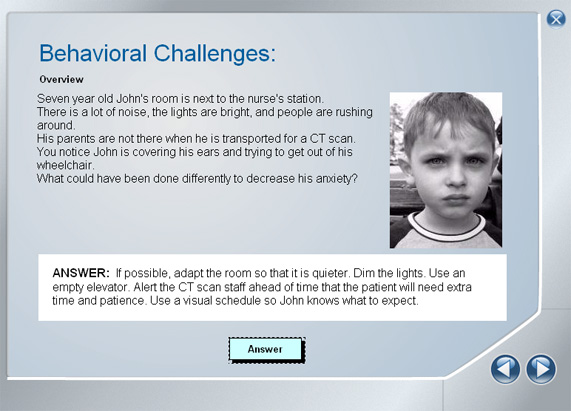|
Items should be written at the application level according to Bloom’s Taxonomy. |
| |
 |
Which (action, statement) (performed, made) by the clinician, demonstrates understanding of (technique, policy, safety issue)? |
| |
 |
Which of the following statements, if made by a parent, indicates a need for further teaching by the clinician? |
| |
 |
Which of the following statements, if made by a parent, indicates understanding of clinician teaching? |
| |
 |
Which of the following four actions is a priority for the clinician to perform? |
| |
 |
Which of the following four symptoms would the clinician be concerned about in a patient following (procedure, test)? |
| |
 |
A clinician is seen performing the following four actions? For which action should a clinician intervene? |
| |
|
| |
For example:
A) Starts I.V. in patient’s room (correct answer)
B) Uses EMLA before I.V. start
C) Calls Child Life to assist I.V. start
D) Asks if parent wants to hold child |
| |
|
 |
Write test items on topics that mirror the course objectives. |
| |
|
| |
For example:
After completion of this lesson the learner will be able to comply with the Clown therapy infection control guidelines. |
| |
|
 |
Each item must consist of a short stem with only the pertinent information to answer the question, one correct answer and three plausible distracters. |
| |
|
| |
For example:
Which statement, if made by the clinician, shows a correct understanding of use of the Clown therapy infection control guidelines?
A) “Clowns should keep a written record of each patient room they enter”. (correct answer)
B) “Clowns are allowed to visit as long as they wear a mask”.
C) “Clowns will be instructed to wear a gown before sitting on the child’s bed”.
D) “Laughing is discouraged because it tends to spread germs”. |
| |
|
 |
Test only one fact such as “what action should the clinician perform?”. |
| |
|
| |
For example of what NOT to do:
What action should the clinician perform when clowns show up on their unit?
A) Ask the clown to wear a mask and record what rooms he or she goes in.
B) Have them wash their hands and gown before sitting on the bed.
C) Keep a record of the rooms they go including how long they are in there.
D) Discourage clowns from visiting as they are a health risk to kids. |
| |
|
 |
Do not use “all of the above”, “none of the above” or other combination answers. Instead, write out plausible distracters. This is because “all of the above” or “none of the above” is generally correct and easily guessed. |
| |
|
|
Do not use “except” or “not” in the stem of the question. This confuses the test taker. |
| |
|
 |
Refrain from writing “dangling” stems. |
| |
|
| |
For example of what NOT to do:
The clinician knows that:
A) Clowns should keep a written record of each patient room they enter.
B) Clowns are allowed to visit as long as they wear a mask.
C) Clowns will be instructed to wear a gown before sitting on the child’s bed.
D) Laughing is discouraged because it tends to spread germs. |
| |
|
 |
Each distracters sentence needs to be the same length. When one distracter is long, it is generally the right answer. It is easy for the test taker to guess. |
| |
|
| |
For example of what NOT to do:
A) Clowns should keep a written record of each patient room and play room that they enter.
B) Clowns should wear a mask.
C) Clowns can sit on the child’s bed.
D) Tell clowns not to laugh. |
| |
|
 |
There should be no overlap in ranges for distracters. |
| |
|
| |
For example (bad question):
When should a clinician tell a clown to get up from sitting on a child’s bed?
A) Immediately
B) After 5-15 minutes
C) After 10-20 minutes
D) At the clown’s discretion |
| |
|
 |
For check your knowledge-type questions, use the same format as multiple-choice questions. |
| |
|
 |
Use true/false questions sparingly since the answer is easy to guess. When you use true/false questions, keep the stem of the question as short as possible. |
| |
|
 |
Case scenarios are best placed at the beginning of an online module to draw the learner into the applicability of the topic to his/her practice. |
| |
|
| |
For example:
In the Behavioral Challenges online course, a case study immediately follows the objectives.

|

